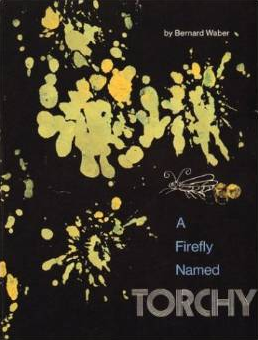
The artwork is almost surreal. There’s streaks of luminous yellows and greens, but the paints mix together in a colorful chaos. “On a warm night at the edge of a woods, a firefly was born,” writes Bernard Waber at the beginning of A Firefly Named Torchy. But he’s also the illustrator, and he’s determined toshowcase the wild beauty of the night – seen from a bug’s-eye view.
“Eat your dinner,” says the firefly’s mother when he was “just a little flicker.” But the text appears in white letters on a beautiful black background, with splotches of grey and green at the bottom to suggest the leaves around his home. And the next page is filled with wild squiggles of yellow, green and white. Making the trail of luminous light is the small firefly, who’ shown in a simple outline drawing . “Everyone was astonished,” writes Waber enthusiastically, because “his light was so bright.”
Waber enjoys the black backgrounds, and splashes them with strange and colorful patterns. When the fireflies “twinkled and glowed” in the night, there’s a two-page spread with bright circles of colored paint dots suggesting a fireworks display. But he’ll use his colors to convey an important turn in the plot. When Torchy turns on his light, the night disappears. He’s so bright that the background turns white instead of black – and the new light reveals all the animals who were hiding in the forest.
It’s a funny twist which creates havoc in the animal kingdom. “Baby birds, thinking it morning, cried out to be fed,” Waber notes, and the other animals started to object. Even the other fireflies complain that “You are supposed to be softly twinkling…” And when Torchy extinguishes his light again – the backgrounds return to break. “Everyone was happy…everyone but Torchy.”
His mother gives him lessons on how to twinkle softly – but Waber can’t resist repeating the joke. When Torchy tries to twinkle, ever so slowly…the background turns bright white again. There’s the fox and the rabbit, the beaver and the frog, all revealed in the dull green bushes. The baby birds beg to be fed again, and soon everyone is clamoring for the darkness again.
The book switches back and forth between bright backgrounds and the black of night. And when Waber draws an owl, it’s a simple outline with blues, greens, and yellow. But he’s suggesting how the owl would look at night – to a bug – as he works his way up to a satisfying message.
“There are many kinds of light in the world,” the owl advises. “You should be mighty proud of yours…”